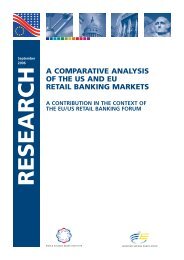Corporate Governance and Access to Finance - ESBG
Corporate Governance and Access to Finance - ESBG
Corporate Governance and Access to Finance - ESBG
You also want an ePaper? Increase the reach of your titles
YUMPU automatically turns print PDFs into web optimized ePapers that Google loves.
2.4. Accountability <strong>to</strong> stakeholdersA challenge of <strong>Corporate</strong> <strong>Governance</strong> of financial institutions, as mentionedabove, is <strong>to</strong> make them accountable not only <strong>to</strong> shareholders, but also <strong>to</strong>deposi<strong>to</strong>rs, taxpayers, supervisors <strong>and</strong> other stakeholders. WSBI members,having their roots firmly based in their community, are in generalaccountable <strong>to</strong> different stakeholders. This is reflected in the diversity oftheir governing bodies, which contributes <strong>to</strong> ensure a balance betweenthe different interests of their stakeholders <strong>and</strong> between the different goalsof the institution. The Peruvian CMACs provide a very interesting examplein this regard: despite having only one shareholder (the municipality),the seven members of the Board are appointed by six differentconstituencies: (i) the majority <strong>and</strong> (ii) the minority representatives in themunicipality, (iii) the chamber of commerce, (iv) the association of smallbusinesses, (v) COFIDE, a public bank <strong>and</strong> (vi) the catholic church.This composition is, furthermore, protected by law. In the case of SpanishCajas, the general assembly composition varies depending on theirstatutes, but it typically includes appointees by deposi<strong>to</strong>rs, municipalities,regional government, employees <strong>and</strong> the founding entity. In the case ofGerman Sparkassen, the composition of the Board of administrationdepends very much on the savings banks Law of the respective L<strong>and</strong>, butit is quite common that the board includes representatives appointed bythe major democratic body of the municipality or district (2/3) <strong>and</strong> thesaving bank’s staff (1/3).The proportion of women in the Board is often used as an indica<strong>to</strong>r ofdiversity. In a sample of 23 WSBI members, the average of womenrepresentation in the Board is 24 percent, as compared <strong>to</strong>, for example,7 percent in EU25 commercial banks, according <strong>to</strong> Mateos de Cabo,Gimeno, <strong>and</strong> Nie<strong>to</strong> (2009). This shows not only that the Board of savingsbanks is more diverse, but also that the interests of minorities are betterrepresented in its composition <strong>and</strong> that the Board is closer <strong>to</strong> certaintypes of clients, according <strong>to</strong> the literature on microfinance institutions(see Annex 1), thus contributing <strong>to</strong> foster <strong>Access</strong> <strong>to</strong> <strong>Finance</strong>.Internal <strong>and</strong> external controls are essential ingredients of <strong>Corporate</strong><strong>Governance</strong>. Most WSBI members comply with st<strong>and</strong>ard good <strong>Corporate</strong><strong>Governance</strong> practices for financial institutions, as defined for instance bythe Basel Committee 8 .8 See BCBS (2010b) <strong>and</strong> Table 6.33
















